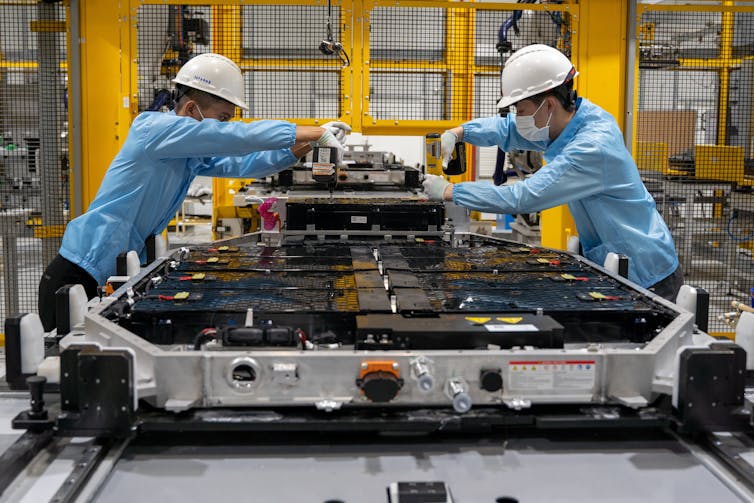
A young boy is forced to sit at a dinner table with grown-ups talking endlessly about grown-up stuff. He’s bored. He finds it hard at first, to push with his feet against the table frame, tip his chair onto its back legs, and straighten his legs. But towards the pivot point it becomes an almost effortless, floating experience, requiring only the slightest toe poke, now and then.
And then … disaster. One toe poke too many is all it takes to pass the point of no return and the boy crash lands on his back.
The boy had gone past the “tipping point” after which change became inevitable. And on a much larger scale, this same process can see glaciers suddenly disappear or rainforests dry up.

We are part of an international team of over 200 authors to have contributed to the new Global Tipping Points Report launched at the COP 28 climate change talks in Dubai.
At least five tipping points in the Earth system require only a slight toe poke to be triggered – including the collapse of major ice sheets, and coral reefs, and an abrupt shift in North Atlantic ocean circulation. These “negative” tipping points are now so close that urgent action needs to be taken to prevent them.
Fortunately, tipping points with good outcomes – “positive” tipping points – are also possible in human technology, economics, politics and social behaviour. In fact, they’re already happening, in areas ranging from renewable energy and electric vehicles, to social movements and plant-based diets. Our report sets out ways to intervene in these systems to enable positive tipping points to be triggered – for example by making the desired change the cheapest, most convenient or morally acceptable option.
Multiple systems can even tip in a domino effect of cascading beneficial change. For example, as we cross the tipping point that sees electric vehicles become the dominant form of road transport, battery technology will continue to get better and cheaper.
This could trigger another positive tipping point in the use of batteries for storing renewable energy, reinforcing another in the use of heat pumps in our homes, and so on. And there are what we call “super-leverage points” – places where we can deliberately intervene with information campaigns, mandates and incentives to create widespread change across sectors.

These actions might sound rather effortless, a final little toe poke that nudges a system past its point of no return and accelerates it towards a new (in this case desired) state. “Just” make the desired technology the cheaper option; bring in a new regulation or mandate; invest in new infrastructure; create new institutions; change habits or social norms; and wait for the system to tip.
But, returning to the image of our young boy, this overlooks all the demanding legwork, especially at the beginning, that it takes to get to that final, pivotal threshold. Any typical example of transformative change that one cares to point to – whether it’s Denmark’s transition to wind power, Columbia’s signature on the Fossil Fuel Non-Proliferation Treaty, or Ecuador’s vote to ban oil drilling in the Amazon – involves a much longer backstory of political struggle.
Curiously, in the case of Norway’s pioneering transition to electric vehicles (EVs) – over 80% of new car sales in Norway are now fully electric – it also involves the pop band a-ha, best known internationally for their 1985 hit Take On Me, appropriately enough for what followed.
The a-ha moment
Back in the late 1980s a-ha’s lead singer Morten Harket and keyboardist “Mags” Furuholmen teamed up with a professor of architecture, Harald Røstvik, and environmentalist Frederic Hauge, and together they began sowing the seeds of a Norwegian transport revolution. Beginning with a campaign to get the public on their side, the group travelled to Switzerland to take part in the solar EV race, the Tour de Sol, with the Norwegian press in tow. They also test-drove a converted electric Fiat Panda: range, 46 kilometres.
Suitably impressed, they set about importing a similar specimen into Norway. They exploited every photo opportunity, and campaigned to make EVs the cheapest, most convenient option by abolishing importation, registration and company car taxes for EVs, exempting EVs from VAT and road tolls, and giving them free access to bus lanes and ferries.
For many years the Norwegian government remained unmoved by a-ha’s demands. In response, a-ha refused to pay the tolls and parking fines. Eventually the car was impounded and auctioned off, to the delight of the national press, who took front row seats. Someone sympathetic to the cause made the winning bid and promptly handed the car back to the pop group.
This cycle was repeated, over and over, until in 1997 EVs were exempted from road tolls in Norway. By 2009, all the campaigners’ demands had been met and the government began investing heavily in public EV charging infrastructure. All the enabling conditions for a positive tipping point had been met and from 2011 Norway’s EV car market started to grow very rapidly.
To limit global heating to as near to +1.5°C as possible we need rapid, exponential change. The whole world needs to replicate Norway’s rapid tipping of the EV market across all sectors and domains of society. The Global Tipping Points Report offers a blueprint for how to achieve a more sustainable future.

Don’t have time to read about climate change as much as you’d like?
Get a weekly roundup in your inbox instead. Every Wednesday, The Conversation’s environment editor writes Imagine, a short email that goes a little deeper into just one climate issue. Join the 20,000+ readers who’ve subscribed so far.
Steven R. Smith is also Tipping Points Research Impact Fellow at the Global Systems Institute, University of Exeter.
Caroline Zimm receives funding from the Earth Commission.
Tim Lenton does not work for, consult, own shares in or receive funding from any company or organisation that would benefit from this article, and has disclosed no relevant affiliations beyond their academic appointment.
This article was originally published on The Conversation. Read the original article.







